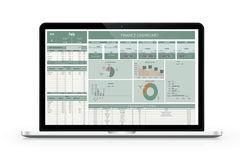Building an emergency fund might seem like a daunting task, but it's one of the most important things you can do for your financial security. An emergency fund acts as a financial cushion that can help you handle unexpected expenses without going into debt. Whether it’s a medical bill, car repair, or even a sudden job loss, having a reserve of cash on hand ensures you’re prepared for whatever life throws your way. Here’s a simple, straightforward guide to building an emergency fund in six easy steps.
Step 1: Set a Realistic Goal
The first step in building an emergency fund is to determine how much you need to save. A good rule of thumb is to aim for three to six months’ worth of living expenses. To figure this out, add up your essential monthly expenses, such as rent or mortgage, utilities, groceries, and insurance. Multiply this total by the number of months you want your emergency fund to cover.
Example: If your monthly expenses are $2,500, you should aim to save between $7,500 and $15,000.
Step 2: Start Small and Be Consistent
Don’t worry if saving a large amount seems overwhelming at first. The key is to start small and be consistent. Begin by setting aside a small portion of each paycheck, even if it’s just $20 or $50. Over time, these small contributions will add up.
Tip: Automate your savings by setting up a direct deposit from your paycheck into your emergency fund. This way, you’ll save money before you have a chance to spend it.
Step 3: Reduce Unnecessary Expenses
Take a close look at your budget and identify areas where you can cut back. This might mean eating out less, canceling unused subscriptions, or finding more affordable alternatives for everyday purchases. The money you save can then be redirected into your emergency fund.
Example: If you save $50 a month by cutting back on dining out, that’s $600 added to your emergency fund over a year.
Step 4: Boost Your Income
Consider finding ways to increase your income, even temporarily, to speed up the growth of your emergency fund. This could involve taking on a side gig, freelancing, selling unused items, or asking for overtime at work.
Tip: Put any bonuses, tax refunds, or unexpected windfalls directly into your emergency fund. It’s an easy way to make a significant impact on your savings without affecting your regular budget.
Step 5: Keep Your Emergency Fund Separate
It’s crucial to keep your emergency fund in a separate, easily accessible account, such as a high-yield savings account. This not only keeps it out of sight (and out of mind) but also ensures that the money is available when you need it without any penalties for withdrawal.
Tip: Avoid putting your emergency fund in an investment account where the value could fluctuate. The goal is to have a stable, readily available source of cash.
Step 6: Stay Committed and Adjust as Needed
Building an emergency fund is a long-term commitment. It’s important to stay focused on your goal, even when it feels like progress is slow. Life circumstances can change, so periodically reassess your goal and adjust your savings plan if necessary. For example, if your expenses increase, you may need to increase your savings target.
Tip: Once you’ve reached your emergency fund goal, continue the habit of saving by redirecting your contributions to other financial goals, like retirement or a down payment on a house.
Final Thoughts
Building an emergency fund is one of the best financial decisions you can make. It takes time, discipline, and patience, but the peace of mind it provides is invaluable. By following these six steps, you’ll be well on your way to creating a financial safety net that can protect you from life’s unexpected twists and turns.
Remember, the journey to financial security starts with a single step. Start today, and your future self will thank you!
